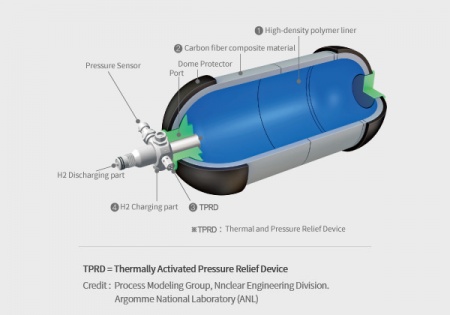Difference between revisions of "Dzalfa Rajaa' Muhammad"
Dzalfa.rajaa (talk | contribs) (Created page with "=Pressurized Hydrogen Storage Optimization= ==Pressurized Hydrogen Storage== : : Pressurized hydrogen storage involves compressing hydrogen gas and storing it in specially des...") |
Dzalfa.rajaa (talk | contribs) (→Pressurized Hydrogen Storage) |
||
| Line 2: | Line 2: | ||
==Pressurized Hydrogen Storage== | ==Pressurized Hydrogen Storage== | ||
: | : | ||
| − | : | + | : In pressurized hydrogen storage, hydrogen gas is compressed and stored in specially designed tanks or cylinders. These tanks are designed to withstand high pressures, typically in the hundreds to thousands of pounds per square inch (psi). Accumulators offer advantages such as simplicity, portability, and reduced refueling time. However, there are also challenges such as weight, security, and storage capacity limitations. Tank materials must be robust and require rigorous testing to prevent leaks and bursts. To overcome these limitations and optimize hydrogen storage and use, alternative storage methods such as cryogenic storage and hydrogen carriers are being explored. |
| − | |||
==Factors Involved in Designing and Optimizing a Pressurized Hydrogen Storage== | ==Factors Involved in Designing and Optimizing a Pressurized Hydrogen Storage== | ||
Revision as of 10:49, 6 June 2023
Pressurized Hydrogen Storage Optimization
Pressurized Hydrogen Storage
- In pressurized hydrogen storage, hydrogen gas is compressed and stored in specially designed tanks or cylinders. These tanks are designed to withstand high pressures, typically in the hundreds to thousands of pounds per square inch (psi). Accumulators offer advantages such as simplicity, portability, and reduced refueling time. However, there are also challenges such as weight, security, and storage capacity limitations. Tank materials must be robust and require rigorous testing to prevent leaks and bursts. To overcome these limitations and optimize hydrogen storage and use, alternative storage methods such as cryogenic storage and hydrogen carriers are being explored.
Factors Involved in Designing and Optimizing a Pressurized Hydrogen Storage
- Designing and optimizing a pressurized hydrogen storage involves several factors and processes to ensure its safety, efficiency, and performance. Here are some key considerations in the design and optimization process:
- Storage Capacity
- The required storage capacity of hydrogen must be determined based on the anticipated demand and usage. Factors such as the desired duration of storage, refill frequency, and system requirements play a role in determining the storage capacity.
- Material Selection
- The choice of materials for the storage tank is crucial. Factors such as material strength, corrosion resistance, hydrogen compatibility, weight, and cost need to be considered. The selected material should meet safety standards, regulatory requirements, and be suitable for the specific application.
- Pressure Requirements
- Determining the optimal operating pressure is critical to balance storage capacity, tank weight, and safety. Higher pressures allow for more hydrogen storage within a given volume, but it increases material requirements and safety considerations. The pressure requirements should align with the intended use and regulatory standards.
- Safety Considerations
- Safety is paramount in hydrogen storage design. Factors such as material integrity, leak prevention, pressure relief mechanisms, and appropriate safety measures need to be incorporated. Standards and guidelines from regulatory bodies, such as the International Organization for Standardization (ISO) and national safety codes, should be followed.
- Structural Design
- The structural design of the storage tank must ensure its mechanical integrity and resistance to external loads, vibrations, and impacts. Finite element analysis (FEA) and other engineering calculations are performed to determine the optimal tank shape, thickness, reinforcement, and support structures.
- Thermal Management
- Hydrogen storage systems may require thermal management to control temperature variations. Insulation, cooling, or heating mechanisms are employed to maintain the desired hydrogen temperature range and prevent thermal stresses.
- Cost Optimization
- Optimization techniques, such as mathematical modeling and numerical methods, can be applied to minimize costs while meeting performance and safety requirements. This includes optimizing material usage, tank size, manufacturing processes, and other relevant parameters.
- Regulatory Compliance
- Compliance with relevant regulations, standards, and codes is essential in the design and operation of pressurized hydrogen storage. It ensures safety, environmental protection, and compatibility with industry norms.
- Hydrogen Purity
- The required purity level of hydrogen for the specific application should be considered. Impurities in the hydrogen stream can impact the integrity and performance of the storage system. Depending on the application, purification processes may be needed to remove impurities.
- Fill and Discharge Rates
- The desired fill and discharge rates of hydrogen affect the design and optimization of the storage system. Factors such as the available infrastructure, operational requirements, and efficiency considerations influence the sizing of valves, piping, and other components.
- System Integration
- Pressurized hydrogen storage systems are often integrated with other components and subsystems, such as hydrogen production units, fuel cells, or transportation systems. Seamless integration and compatibility with these systems are important to ensure overall system performance.
- Environmental Considerations
- Environmental factors, including temperature variations, exposure to corrosive substances, and seismic activity, should be taken into account during the design process. Adequate protection and design measures, such as coatings, seismic restraints, and environmental monitoring, may be required.
- Manufacturing and Fabrication Methods
- The manufacturing and fabrication techniques employed impact the quality, cost, and scalability of the storage system. Selection of appropriate manufacturing methods, such as welding, forming, or composite layup, needs to be aligned with the chosen materials and desired characteristics.
